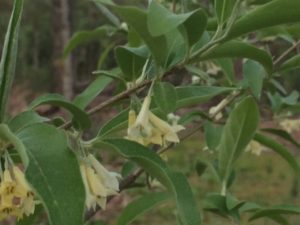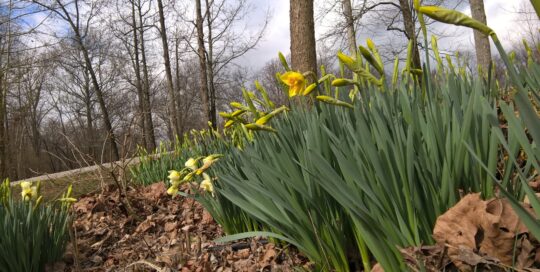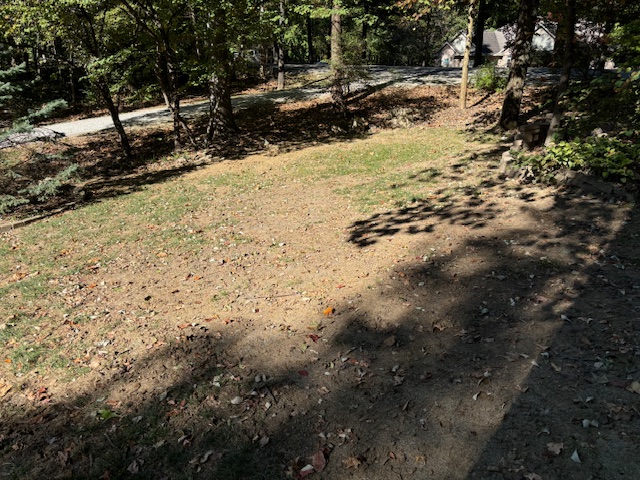Alien Invaders – Autumn and Russian Olive Trees
Views: 541

Yesterday, I went on a hunt in our woods. Nooo, not for morel mushrooms, although it’s getting to be that time of the year. Nooo, not for those nasty voles who are definitely eating my hostas and my irises. Not even for the raccoons that steal the suet from my bird feeder. I went hunting for Autumn olive trees (Elaeagnus umbellata). They are also known as umbellate oleaster, autumn elaeagnus, Japanese silverberry or spreading oleaster.
Autumn and Russian Olive Trees
Once upon a time, a long time ago, I remember reading glowing articles in Mother Earth News about Autumn and Russian olive trees. Yeah, I was one of those kind of people – although I never inhaled – I swear! The trees grew quickly (true). The trees were excellent windbreaks (true). Also, the trees had intensely fragrant, pale yellow blossoms (true). The trees bore berries which were edible for humans and loved by wildlife (also true). So, like Dude! What’s the problem?
What we didn’t know then, but do know now is that both Autumn and Russian olives are too successful in a good portion of our country. They leaf out way before other trees; in fact, if you see green leaves on small, nearly bush-type trees in March in Zone 6, they are very likely Autumn or Russian olives. If you see white blossoms on tear-drop shaped trees in March, those are likely Callery (Bradford) pears – also invasive, but that’s another blog. Nowadays, I’m suspicious of any plant that comes from Korea, China or Japan. So many of them have become invasive (no inference intended to the COVID 19 virus, but come to think of it…).
As with most plants and animals which become invasive, it takes time for us humans to figure out there’s a problem. A plant or animal is introduced; sometimes by accident, like Zebra mussels and sometimes deliberately, like starlings and Autumn / Russian olives.
Invaders
The plant or animal finds its new environment very welcoming; there are few, if any, predators or competition; the climate is perfect and it does what any living thing would do – live long and prosper (yeah, I was a Trekkie as well). Another analogy: think of James Bond 007 in Las Vegas and he’s the only man on the Strip.
I probably cut down 50 or more Autumn olive trees and took out a bunch of Japanese honeysuckle vines as well. I’ll have to go back into the woods several more times before these stubborn plants decide to die. How do I try to kill them? If the trunks are small enough to cut with my clippers or loppers (brand name is “Corona” – ain’t that ironic?), I take great pleasure in cutting them down.
Then, (please don’t stone me), I carefully spritz a tiny bit of a strong solution of glyphosate herbicide and water onto the cut surface. Sometimes, the plant is young enough that I can simply pull it out by its roots – very good feeling there, believe me! If it’s too big for my Corona loppers, Wonderful Husband comes to the rescue with his chain saw. After he’s cut through, I carefully administer the glyphosate solution. I do NOT like using commercial herbicides, but this is really a war against invasives.
I’m certainly not finished yet. I know I will have to wade into the woods every year to eliminate new plants and try to complete killing the older ones.
If you want to prevent invasive plants or identify those that are in your area, contact your County Extension Agent or your Master Gardeners’ Association. They should be able to give you great advice about what plants to eliminate. They’ll also tell you the best way to do it and what plants to avoid.
Stay Green (and Healthy), Good Friends!
Meet Dona Bergman
Dona Bergman is a founding member, Southwest Indiana Chapter of the Indiana Native Plant & Wildlife Society, and an Advanced Master Gardener.







